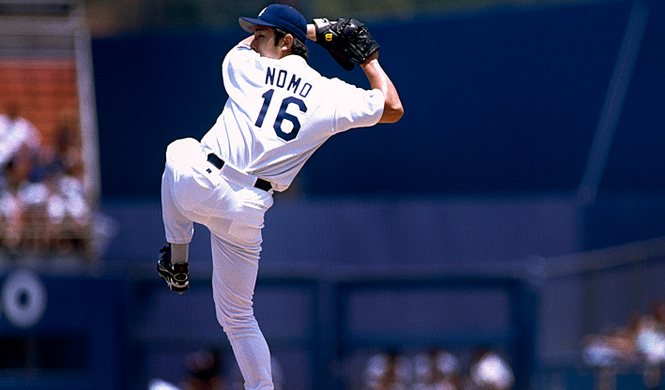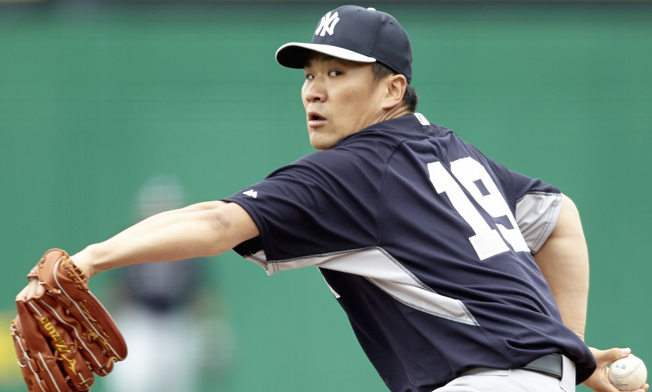Comparing Masahiro Tanaka To Other Foreign Import Phenoms
The season is shaping up as a long one for the geriatric Yankees who, to their credit, are still keeping their heads above water at 21-19. But barring what would be an even more catastrophic injury, Yankees fans will still have something to look forward to every fifth day, thanks to Japanese phenom Masahiro Tanaka.
Last year for the Rakuten Golden Eagles of the NPB Tanaka went 24-0 with a 1.27 ERA. Those are more than just video game numbers. They would be an indication you need to get a more difficult video game.
While there was no way he could repeat those numbers in MLB, his current stats, 6-0 with a 2.17 ERA and over a strikeout an inning, make him the odds-on favorite for not just Rookie of The Year but for the American League Cy Young.
However, we can’t be sure Tanaka will continue to pitch at quite this high of a level. MLB has a history adjusting to exotic imports after they’ve seen them a few times. Check out how other foreign phenoms have feared after their novelty wore off.
Fernando Valenzuela
Velenzuela is a bit different from the others on this list because he did do about a year in the minors after the Dodgers plucked him from the Mexican Leagues. He gave up no earned runs in ten relief appearances for the big club in 1980, and then utterly dominated out of the gate in his official rookie year of 1981, starting the season 8-0 with five shutouts and a .50 ERA and sparking “Fernandomania” all over Southern California. The rest of that strike-shortened season was actually pretty mediocre for Velenzuela, 5-7 with a 3.66 ERA. Still, his total stats were 13-7, 2.48 and league-leading 180 strikeouts, enough for the NL Cy Young. He also helped the Dodgers to the ’81 World Series title and was almost as good in 1982, going 19-13 with a 2.87 ERA. The rest of his career with Dodgers was up and down; he was great in 1985 and 1986, not so great in the two years before that, and pretty washed up by the late eighties. Valenzuela’s was undoubtedly a good career, although it never quite lived up to the promise of its first few months.
Hideo Nomo
In 1995, Nomo became the first Japanese player in the Major Leagues in 30 years. It took him about a month to get acclimated and he wouldn’t get his first win for the Dodgers until his seventh start. But once he did, he went on a Velenzuela-like run that sparked a new sort of LA-area mania. Between that seventh start and his 21st, Nomo would go 10-2 with a 1.55 ERA and over a strikeout an inning. He finished his rookie season 13-6 with a 2.54 ERA and league-leading 236 punch outs. In 1996, he went 16-11 with a 3.19 ERA and finished fourth in NL Cy Young voting for the second year in a row. However, the league began to catch up to Nomo’s funky delivery and forkball in 1997, and he was pretty much an average pitcher for the rest of his career. He did have some high points: he led the AL in strikeouts for the Red Sox in 2001 and followed that up with two fine years back with the Dodgers But, overall, if Tanaka has a similar career path to his countryman the Yankees will be mighty disappointed.

Jose Contreras
Contreras had been a dominate pitcher in Cuba before defecting to the United States in 2003. But since Cuban baseball players almost never made it to MLB — Livan Hernandez had defected eight years earlier as a 20-year old, but hadn’t established himself in Cuban baseball at that point — nobody was quite sure what to expect when the Yankees signed Contreras to a four-year deal. He was pretty good out of the gate, going 7-2 with a 3.30 ERA (which was 34 percent above the league average) as 31-year old rookie who rotated between starting and relieving. A full-time move to the rotation in 2004 wasn’t successful, and the Yankees traded him mid-season to the White Sox. Contreras would pitch another decade, always an useful arm but rarely a particularly good one.
Daisuke Matsuzaka
The Red Sox famously paid Matsuzuka’s Japanese club, the Suibe Lions, $ 51 million just for the exclusive rights to Dice-K. Then Boston signed the righty to a six-year $52 million deal. In his first year in MLB, 2007, he showed promise, finishing 15-12 with a 4.40 ERA (eight percent above league average) and 201 strikeouts. In his second season he started to really earn his money, going 18-3 with a 2.90 ERA. But he also led the league in walks, and his lack of control, along with shoulder troubles, would led to a pretty rapid undoing. Matsuzaka is seeing some success this year for the Mets out of the bullpen, but has been a pretty lousy pitcher since 2008.
Yu Darvish
If Matsuzuka is the worst case scenario for Tanaka, Darvish would be the best. He’s only in his third season — so he could very well go the way of Dice-K himself. But so far Darvish has improved every year and can safely be considered a top ten pitcher in the league, if not top five. Darvish was in the news last week for coming within one out of a no-hitter, the second time that’s happened to him in his short career.
